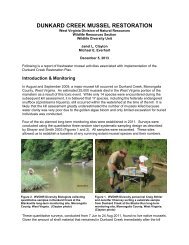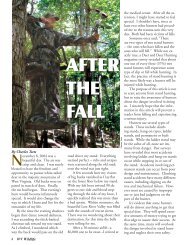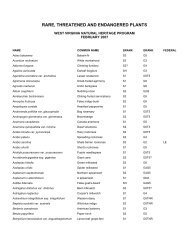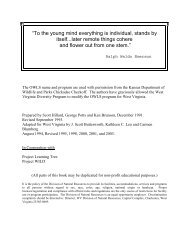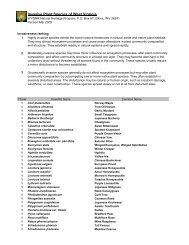Snakes - West Virginia Division of Natural Resources
Snakes - West Virginia Division of Natural Resources
Snakes - West Virginia Division of Natural Resources
Create successful ePaper yourself
Turn your PDF publications into a flip-book with our unique Google optimized e-Paper software.
Mizuki Takahashi<br />
CORNSNAKE (Elaphe g. guttata)<br />
Red dorsal blotches<br />
outlined in black against<br />
a light brown background<br />
make this one <strong>of</strong> our most<br />
attractive snakes. Cornsnakes<br />
can reach six feet<br />
in length and its scales<br />
are weakly keeled. Cornsnakes<br />
have been collected<br />
in Eastern Panhandle<br />
farmlands where they feed<br />
on small rodents. About<br />
10-15 white, elliptical<br />
eggs are deposited each<br />
year.<br />
BLACK RATSNAKE (Elaphe o. obsoleta)<br />
This common and useful snake may exceed 6 feet in length, which<br />
makes it one <strong>of</strong><br />
our state’s largest<br />
snakes. This<br />
shiny black reptile<br />
normally exhibits<br />
traces <strong>of</strong> its<br />
spotted juvenile<br />
pattern (light cross<br />
bars <strong>of</strong> white,<br />
cream or yellow)<br />
throughout its<br />
adult life. The<br />
belly is light-col-<br />
Nonvenomous juvenile Black Ratsnakes,<br />
right, are <strong>of</strong>ten misidentifi ed as venomous<br />
Copperheads. The former’s bands are more<br />
close together, while the Copperhead’s bands<br />
are spaced further apart and have a more<br />
hourglass shape.<br />
13<br />
Tom Allen<br />
Nanci Bross-Fregonara



